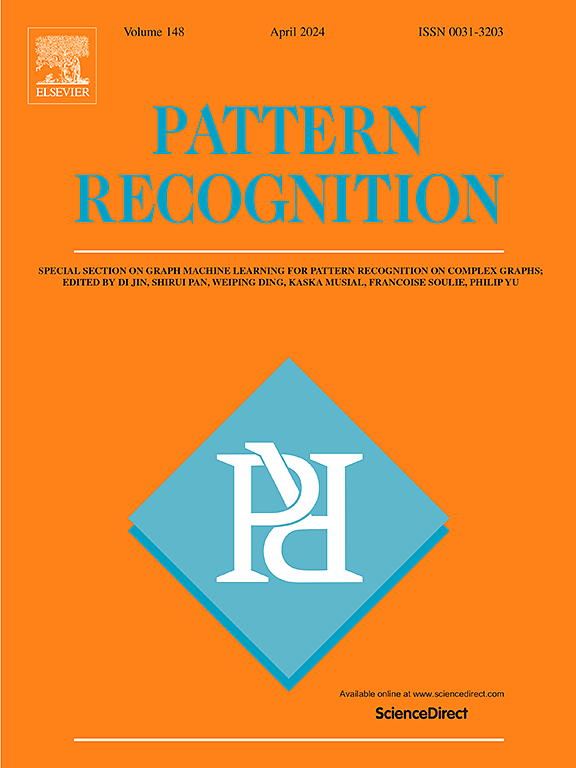Hyperspectral image restoration via the collaboration of low-rank tensor denoising and completion
IF 7.5
1区 计算机科学
Q1 COMPUTER SCIENCE, ARTIFICIAL INTELLIGENCE
引用次数: 0
Abstract
Hyperspectral images (HSIs) are always damaged by various types of noise during acquisition and transmission. Low-rank tensor denoising methods have achieved state-of-the-art results in current HSIs restoration tasks. However, all these methods remove the mixed noise in HSI based on the representation of image prior information. In this paper, we consider a problem for the first time: Structured noise like stripes and deadlines confounds image priors, hindering effective image-noise separation in current approaches. Motivated by this, a new HSI restoration model based on the collaboration of low-rank tensor denoising and completion (LR-TDTC) is proposed. Firstly, the structured noise detection algorithm is applied to identify the positions of structured noise such as stripes and deadlines, achieving the separation of unstructured noise and structured noise. The entries in the structured noisy area are removed. Then, for unstructured noise, a tensor denoising module (TD) based on image prior representation is introduced to separate images and noise. For structured noise, a tensor completion module (TC) based on full-mode-augmentation tensor train rank minimization is introduced to complete the noise area. Finally, the two modules collaborate through the mutual utilization of information to achieve the restoration of the entire image. To solve the LR-TDTC model, a variable tessellation iterative algorithm (VTI) is proposed. VTI utilizes a serialization strategy to enable TD and TC modules to effectively utilize each other's latest iteration results, achieving efficient collaboration between the two. The mixed noise removal experiments on multiple HSIs show that the proposed method has outstanding advantages.
基于低阶张量去噪和补全协同的高光谱图像复原
高光谱图像在采集和传输过程中经常受到各种噪声的干扰。低秩张量去噪方法在当前hsi恢复任务中取得了最先进的结果。然而,这些方法都是基于图像先验信息的表示来去除HSI中的混合噪声。在本文中,我们首次考虑了一个问题:像条纹和截止日期这样的结构化噪声会混淆图像先验,阻碍当前方法中有效的图像-噪声分离。为此,提出了一种基于低秩张量去噪与补全协同的HSI恢复模型(LR-TDTC)。首先,利用结构化噪声检测算法识别条纹、截止点等结构化噪声的位置,实现非结构化噪声与结构化噪声的分离;在结构化噪声区域的条目被删除。然后,针对非结构化噪声,引入基于图像先验表示的张量去噪模块(TD)实现图像与噪声的分离;对于结构化噪声,引入基于全模增强张量列秩最小化的张量补全模块(TC)来补全噪声区域。最后,两个模块通过信息的相互利用协同工作,实现对整个图像的复原。为了求解LR-TDTC模型,提出了一种变量镶嵌迭代算法(VTI)。VTI采用序列化策略,使TD和TC模块能够有效地利用彼此的最新迭代结果,实现两者之间的高效协作。在多个hsi上进行的混合去噪实验表明,该方法具有明显的优越性。
本文章由计算机程序翻译,如有差异,请以英文原文为准。
求助全文
约1分钟内获得全文
求助全文
来源期刊

Pattern Recognition
工程技术-工程:电子与电气
CiteScore
14.40
自引率
16.20%
发文量
683
审稿时长
5.6 months
期刊介绍:
The field of Pattern Recognition is both mature and rapidly evolving, playing a crucial role in various related fields such as computer vision, image processing, text analysis, and neural networks. It closely intersects with machine learning and is being applied in emerging areas like biometrics, bioinformatics, multimedia data analysis, and data science. The journal Pattern Recognition, established half a century ago during the early days of computer science, has since grown significantly in scope and influence.
 求助内容:
求助内容: 应助结果提醒方式:
应助结果提醒方式:


